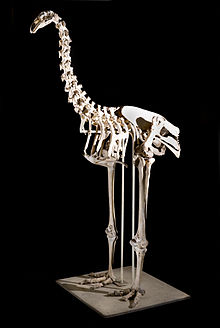South Island giant moa
| South Island giant moa Temporal range: Late Holocene
| |
|---|---|

| |
| Skeleton | |
| Scientific classification | |
| Kingdom: | Animalia |
| Phylum: | Chordata |
| Class: | Aves |
| Infraclass: | Palaeognathae |
| Order: | †Dinornithiformes |
| Family: | †Dinornithidae |
| Genus: | †Dinornis |
| Species: | †D. robustus
|
| Binomial name | |
| †Dinornis robustus | |
| Synonyms | |
|
List
| |
The South Island giant moa (Dinornis robustus) is a member of the moa family. It was a ratite and a member of the order Dinornithiformes. The Dinornithiformes are flightless birds with a sternum without a keel. They also have a distinctive palate. The origin of these birds is becoming clearer as it is now believed that early ancestors of these birds were able to fly and flew to the southern areas in which they have been found.[2]
The South Island giant moa was the biggest of them all. Adult females stood up to 2 metres (6 ft 6 in) high at the back, and could reach foliage up to 3.6 metres (11 ft 10 in) off the ground, making them the tallest bird species known.[2][3] Only one specimen of complete or partially complete moa egg has been assigned to the South Island giant moa, found around Kaikōura. This egg, 240mm in length and 178mm in width, is the largest moa egg found in museum collections as of 2006.[4]


It lived in the South Island of New Zealand as well as in Rakiura,[5] and its habitat was the lowlands (shrubland, duneland, grassland, and forests).[2] Along with other members of the moa family, the South Island giant moa went extinct due to predation from humans in the centuries following human colonization. [6]
Footnotes[]
- ^ Checklist Committee Ornithological Society of New Zealand (2010). "Checklist-of-Birds of New Zealand, Norfolk and Macquarie Islands and the Ross Dependency Antarctica" (PDF). Te Papa Press. Retrieved 4 January 2016.
- ^ a b c Davies, S. J. J. F. (2003)
- ^ Szabo, M.J. 2013. South Island giant moa. In Miskelly, C.M. (ed.) New Zealand Birds Online. www.nzbirdsonline.org.nz
- ^ Gill, B.J. (2006). "A CATALOGUE OF MOA EGGS (AVES: DINORNITHIFORMES)". Records of the Auckland Museum. 43: 55–80. ISSN 1174-9202.
- ^ "A partial skeleton provides evidence for the former occurrence of moa populations on Rakiura Stewart Island". 15 November 2021.
- ^ Perry, George L.W.; Wheeler, Andrew B.; Wood, Jamie R.; Wilmshurst, Janet M. (2014-12-01). "A high-precision chronology for the rapid extinction of New Zealand moa (Aves, Dinornithiformes)". Quaternary Science Reviews. 105: 126–135. doi:10.1016/j.quascirev.2014.09.025 Retrieved 2014-12-22.
References[]
- Brands, Sheila (Aug 14, 2008). "Systema Naturae 2000 / Classification, Genus Dinornis". Project: The Taxonomicon. Retrieved Feb 4, 2009.
- Davies, S.J.J.F. (2003). "Moas". In Hutchins, Michael (ed.). Grzimek's Animal Life Encyclopedia. Vol. 8 Birds I Tinamous and Ratites to Hoatzins (2 ed.). Farmington Hills, MI: Gale Group. pp. 95–98. ISBN 0-7876-5784-0.
Szabo, M.J. 2013. South Island giant moa. In Miskelly, C.M. (ed.) New Zealand Birds Online. www.nzbirdsonline.org.nz
External links[]
- South Island Giant Moa. Dinornis robustus. by Paul Martinson. Artwork produced for the book Extinct Birds of New Zealand, by Alan Tennyson, Te Papa Press, Wellington, 2006
- Dinornithinae
- Birds of the South Island
- Holocene extinctions
- Extinct flightless birds
- Extinct birds of New Zealand
- Late Quaternary prehistoric birds
- Ratites
- Birds described in 1846
